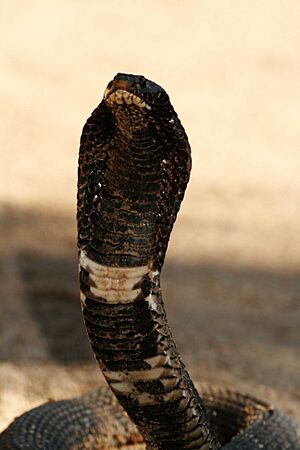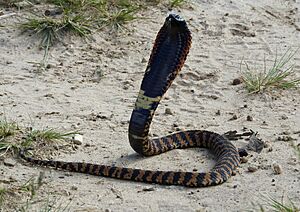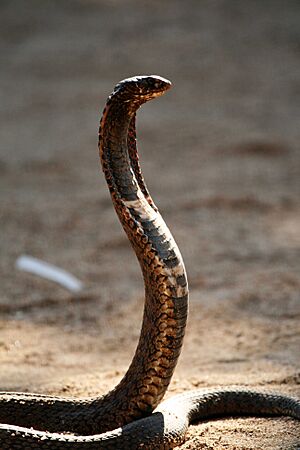Rinkhals facts for kids
Quick facts for kids Rinkhals |
|
|---|---|
 |
|
| Conservation status | |
| Scientific classification | |
| Genus: |
Hemachatus
|
| Species: |
haemachatus
|
| Synonyms | |
The rinkhals (Hemachatus haemachatus), also known as the ringhals or ring-necked spitting cobra, is a type of venomous snake. It lives in parts of southern Africa. Even though it looks like a cobra, it's not a "true" cobra. This means it belongs to a different group of snakes. Rinkhals snakes have some special features that set them apart from true cobras.
In 2023, a group of rinkhals snakes found in Zimbabwe was named a new species, H. nyangensis.
Contents
What Does a Rinkhals Look Like?
Rinkhals snakes come in different colours depending on where they live. A key feature is their dark belly with one or two light-coloured bands on their throat. They usually grow to be about 90 to 110 centimetres long. Some rinkhals are mostly black, while others have stripes.
Their scales are also special. Unlike true cobras, rinkhals have scales that are ridged, almost like a keel on a boat.
Where Do Rinkhals Live?
You can find rinkhals in many areas of South Africa, including the Western and Eastern Cape, Free State, Lesotho, KwaZulu-Natal, Western Eswatini, Mpumalanga, and parts of Gauteng. There was also a group of these snakes near Inyanga, on the border of Zimbabwe and Mozambique. However, there haven't been any recent sightings there, so they might no longer be in that area.
How Rinkhals Behave and What They Eat
Rinkhals snakes enjoy a varied diet. Their favourite food is toads, but they also eat small mammals, other amphibians, and different reptiles.
Unlike many other snakes, rinkhals give birth to live young. This is called being ovoviviparous. A mother rinkhals usually has between 20 and 35 babies at a time. However, some have been known to have as many as 65 young!
Rinkhals Venom
The venom of a rinkhals snake is special. It can affect your nerves (neurotoxic) and also damage cells (cytotoxic). It's not as thick as the venom of some other African snakes.
When a rinkhals feels threatened by a human, it often tries to spray its venom towards the person's face. If the venom gets into your eyes, it can cause a lot of pain. If it gets into a bite, it can cause pain and even tissue damage due to its cell-damaging effects.
Good news! There is a special medicine called antivenom in South Africa that can help if someone is bitten by a rinkhals.
What Happens After a Rinkhals Bite?
If a rinkhals bites someone, about a quarter of the time, the area around the bite might swell and bruise. People who are bitten often feel tired, sick to their stomach, or might even vomit. They can also experience strong stomach pain, cramps, and dizziness. Sometimes, they might even get a mild fever.
How Rinkhals Defend Themselves
If a rinkhals feels scared or bothered, it will spread its neck to form a wide hood. This shows off the unique stripes on its neck. It can also spray its venom up to 2.5 metres away! When it sprays, it often rears up and throws its body forward. This is because, unlike true spitting cobras, its aim isn't always perfect. But it can still spit without doing this big movement.
Rinkhals are also very good at pretending to be dead. They will roll onto their back with their mouth open, looking very convincing! This trick helps them escape danger.
Where Rinkhals Like to Live
Rinkhals snakes usually prefer to live in grassland areas. This helps them blend in with their surroundings and stay hidden. They can also be found living in swamps in southern Africa.





